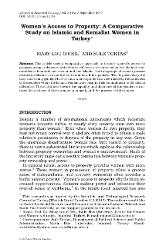Women's Access to Property: A Comparative Study on Islamic and Kemalist Women in Turkey
Abstract
This article uses a comparative approach to discuss women's access to property using evidence collected from field research conducted on two distinct communities of Istanbul: one secular and one Islamic. The two groups of women possess distinctly different views of the world and how it is organized. This is particularly the case concerning gender where secular women put forth a view rooted in the sameness of the genders where the Islamic women were clear in their commitment to the idea of difference. These attitudes toward the equality and difference of the genders structures the relations of these women to property and the process of inheritance.
Source
Journal of Historical SociologyVolume
30Issue
3Collections
Related items
Showing items related by title, author, creator and subject.
-
The role of gender differences in understanding of the east and eastern women:the portrayal of turkish women by american male and female writers in 19th century
Elibol Sevdeğer, Gökşen (Kadir Has Üniversitesi, 2012)The purpose of this thesis is to analyze the different representations of Turkish women by American male and female writers in 19th century. it signifies that American male writers mystify exoticise and exaggerate Turkish ... -
How Do Women Receive Inheritance? The Processes of Turkish Women's Inclusion and Exclusion from Property
Toktaş, Şule; O'Neil, Mary Lou (SOOKMYUNG WOMENS UNIV, 2013)This article employs Turkey as a case study to explore the relationship between property ownership inheritance and women's empowerment. In Turkey as in much of the world men dominate ownership of property. This is despite ... -
Feminists' dilemma-with or without the state? Violence against women and women's shelters in Turkey
Toktaş, Şule; Diner, Çağla (Ewha Womans Univ Press, 2011)This article aims to describe the achievements of the women's movement in the struggle against domestic violence in Turkey and the points of contention between the state and feminists regarding this issue. Our goal in ...
















